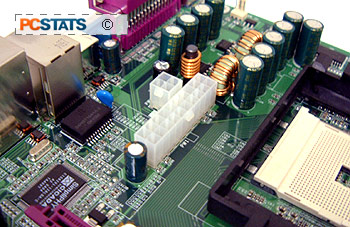Another
area nVIDIA received a lot of flak from end users about, with respect to the
NF3-150 chipset, was the way they implemented HyperTransport. It only ran at 600
MHz and to make things even worse, the upstream connection was only 8-bits wide!
In comparison, VIA's K8T800 HyperTransport moved data along at the full 800 MHz
bus speed, while running on a 16-bit wide bus both up, and downstream.
HyperTransport and AGP/PCI
Locks
In theory this would mean that VIA's implementation
of HyperTransport would be faster but in real world benchmarks it didn't seem to
make much of a difference (though VIA did enjoy a small lead). Still, you can
bet nVIDIA's competition let the world know that the nForce3-150's
HyperTransport moved slower.
 In the server world a slower HyperTransport should
be more apparent due to the higher bandwidth needs of those computers.
nVIDIA silenced all their critics with the
NF3-250, making certain that both Hypertransport streams (up and down) are 16
bits wide, and paced at 1000MHz instead of 800MHz. At this speed, nVIDIA has no
rivals, and currently has the fastest Athlon64 platform out.
In the server world a slower HyperTransport should
be more apparent due to the higher bandwidth needs of those computers.
nVIDIA silenced all their critics with the
NF3-250, making certain that both Hypertransport streams (up and down) are 16
bits wide, and paced at 1000MHz instead of 800MHz. At this speed, nVIDIA has no
rivals, and currently has the fastest Athlon64 platform out.
While ATI focused on creating an Intel chipset,
nVIDIA have been producing some pretty nice AMD chipsets for both K7 and K8
platforms - though they never seem to get it right the first time out. Nvidia
were first to introduce a dual channel memory architecture for the AMD platform,
and they were also first to lock the AGP/PCI bus.
While the nForce3-150 had AGP/PCI locking
capabilities, for one reason or another manufacturers never seemed to adopt
them. Things are different this time around; all nForce3-250 based motherboards
we've tested feature functioning AGP/PCI locks. This frees up enthusiasts
overclock better, and not worry about their other system components (like
videocard or Serial ATA HDD's) holding them back.
Overclocking Tests:
